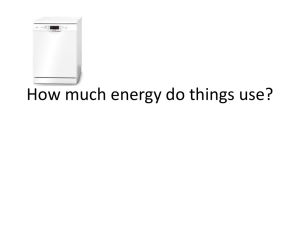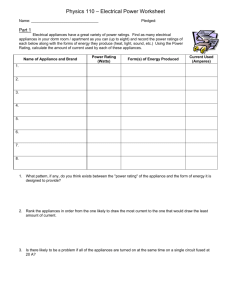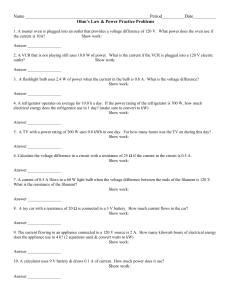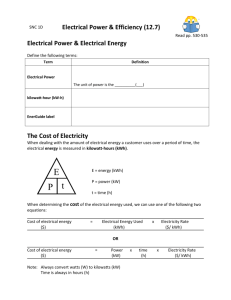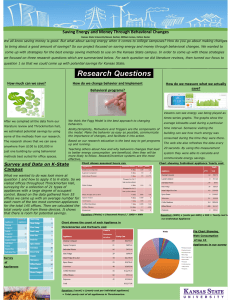Generators supply electrical energy.
advertisement
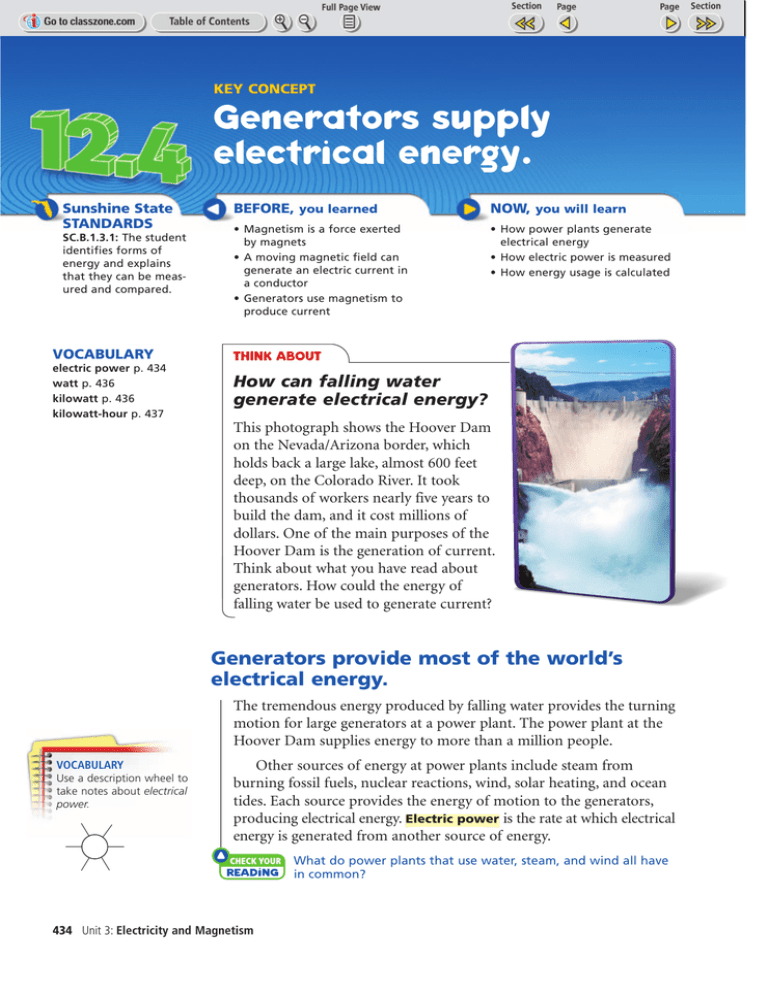
KEY CONCEPT Generators supply electrical energy. Sunshine State STANDARDS SC.B.1.3.1: The student identifies forms of energy and explains that they can be measured and compared. BEFORE, you learned NOW, you will learn • Magnetism is a force exerted by magnets • A moving magnetic field can generate an electric current in a conductor • Generators use magnetism to produce current • How power plants generate electrical energy • How electric power is measured • How energy usage is calculated VOCABULARY THINK ABOUT electric power p. 434 watt p. 436 kilowatt p. 436 kilowatt-hour p. 437 How can falling water generate electrical energy? This photograph shows the Hoover Dam on the Nevada/Arizona border, which holds back a large lake, almost 600 feet deep, on the Colorado River. It took thousands of workers nearly five years to build the dam, and it cost millions of dollars. One of the main purposes of the Hoover Dam is the generation of current. Think about what you have read about generators. How could the energy of falling water be used to generate current? Generators provide most of the world’s electrical energy. The tremendous energy produced by falling water provides the turning motion for large generators at a power plant. The power plant at the Hoover Dam supplies energy to more than a million people. VOCABULARY Use a description wheel to take notes about electrical power. Other sources of energy at power plants include steam from burning fossil fuels, nuclear reactions, wind, solar heating, and ocean tides. Each source provides the energy of motion to the generators, producing electrical energy. Electric power is the rate at which electrical energy is generated from another source of energy. Check Your Reading 434 Unit 3: Electricity and Magnetism What do power plants that use water, steam, and wind all have in common? How does the power plant convert the energy of motion into electrical energy? Very large generators in the plant hold powerful electromagnets surrounded by massive coils of copper wire. The illustration below shows how the energy from water falling from the reservoir to the river far below a dam is converted to electrical energy. 1 As the water falls from the reservoir, its kinetic energy increases and it flows very fast. The falling stream of water turns a fan-like device, called a turbine, which is connected to the generator’s shaft. 2 The rotation of the shaft turns powerful electromagnets that are surrounded by the coil of copper wires. The coil is connected to a step-up transformer that sends high-voltage current to power lines. 3 Far from the plant, step-down transformers reduce the voltage so that current can be sent through smaller lines to neighborhoods. Another transformer reduces the voltage to the level needed to operate lights and appliances. RESOURCE CENTER CLASSZONE.COM Find out more about dams that generate current. How Electrical Power Is Generated Power plants use generators to convert kinetic energy into electrical energy. step-up transformers step-down transformers 3 shaft 2 turbine 1 2 1 Falling water provides energy to turn the turbine of the generator. 3 The shaft turns a powerful electromagnet within a coil of wire, generating electrical current. Current is sent along power lines at a high voltage. The voltage level is adjusted by transformers. How is kinetic energy turned into electrical energy visuals question in aReading power plant? Chapter 12: Magnetism 435 Electric power can be measured. You have read that electric power is the rate at which electrical energy is generated from another source of energy. Power also refers to the rate at which an appliance converts electrical energy back into another form of energy, such as light, heat, or sound. In order to provide electrical energy to homes and factories, power companies need to know the rate at which energy is needed. Power can be measured so that companies can determine how much energy is used and where it is used. This information is used to figure out how much to charge customers, and it is used to determine whether more electrical energy needs to be generated. To provide energy to an average home, a power plant needs to burn about four tons of coal each year. RESOURCE CENTER CLASSZONE.COM Learn more about energy use and conservation. Watts and Kilowatts The unit of measurement for power is the watt (W). Watts measure the rate at which energy is used by an electrical appliance. For instance, a light bulb converts energy to light and heat. The power rating of the bulb, or of any device that consumes electrical energy, depends on both the voltage and the current. The formula for finding power, in watts, from voltage and current, is shown below. The letter I stands for current. Electric Power Voltage p Current P VI Typical Power Ratings Appliance Watts DVD player 20 Radio 20 Video game system 25 Electric blanket 60 Light bulb 75 Stereo system 100 Window fan 100 Television 110 Computer 120 Computer monitor 150 Refrigerator 700 Air conditioner 1000 Microwave oven 1000 Hair dryer 1200 Clothes dryer 3000 436 Unit 3: Electricity and Magnetism You have probably seen the label on a light bulb that gives its power rating in watts—usually in the range of 40 W to 100 W. A brighter bulb converts energy at a higher rate than one with a lower power rating. The chart at the left shows typical power ratings, in watts, for some appliances that you might have in your home. The exact power rating depends on how each brand of appliance uses energy. You can find the actual power rating for an appliance on its label. The combined power rating in a building is likely to be a fairly large number. A kilowatt (kW) is a unit of power equal to one thousand watts. All of the appliances in a room may have a combined power rating of several kilowatts, but all appliances are not in use all of the time. That is why energy is usually calculated based on how long the appliances are in use. check your reading Explain what kilowatts are used to measure. Power How would you use your electrical energy? SKILL FOCUS Making models PROCEDURE 1 On a sheet of graph paper, outline a box that is 10 squares long by 18 squares wide. The box represents a room that is wired to power a total of 1800 W. Each square represents 10 W of power. 2 From the chart on page 436, choose appliances that you want in your MATERIALS • graph paper • colored pencils TIME 30 minutes room. Using colored pencils, fill in the appropriate number of boxes for each appliance. 3 All of the items that you choose must fit within the total power available, represented by the 180 squares. WHAT DO YOU THINK? • How did you decide to use your electrical energy? • Could you provide enough energy to operate everything you wanted at one time? CHALLENGE During the summer, power companies sometimes cannot produce enough energy for the demand. Why do you think that happens? Calculating Energy Use The electric bill for your energy usage is calculated based on the rate at which energy is used, or the power, and the amount of time it is used at that rate. Total energy used by an appliance is determined by multiplying its power consumption by the amount of time that it is used. Energy used Power p time E Pt The kilowatt-hour is the unit of measurement for energy usage. A kilowatt-hour (kWh) is equal to one kilowatt of power for a one-hour period. Buildings usually have meters that measure how many kilowatthours of energy have been used. The meters display four or five small dials in a row, as shown in the photograph on the right. Each dial represents a different place value—ones, tens, hundreds, or thousands. For example, the meter in the photograph shows that the customer has used close to 9000 kWh of energy—8933 kWh, to be exact. To find how much energy was used in one month, the last month’s reading is subtracted from this total. Chapter 12: Magnetism 437 To determine the number of kilowatt-hours of energy used by an appliance, find its wattage on the chart on page 436 or from the label. Then, substitute it into the formula along with the number of hours it was in use. Solve the sample problems below. Finding Energy Used Sample Problem How much energy is used to dry clothes in a 3 kW dryer for 30 minutes? What do you know? Power 3.0 kW, time 0.5 hr What do you want to find out? Energy used Write the formula: E Pt Substitute into the formula: E 3.0 kW p 0.5 hr Calculate and simplify: E 1.5 kWh Check that your units agree: Unit is kWh. Unit for energy used is kWh. Units agree. Answer: 1.5 kWh Practice the Math 1. All of the appliances in a computer lab are in use for 6 hours every day and together use 3.3 kW. How much energy has been used in 1 day? 2. How much energy is used when a 1.2 kW hair dyer is in use for 0.2 hr? Energy prices vary, but you can estimate the cost of using an electrical appliance by using a value of about 8 cents/kWh. You can calculate how much energy you can save by turning off the lights or television when you are not using them. Although the number may seem small, try multiplying your savings over the course of a month or year. KEY CONCEPTS CRITICAL THINKING 1. How do power plants generate electrical energy from kinetic energy? 4. Apply Think about reducing energy usage in your home. What changes would make the largest difference in the amount of energy used? 2. Explain what watts measure. 3. How is energy use determined? 438 Unit 3: Electricity and Magnetism 5. Calculate How much energy is used if a 3000 W clothes dryer is used for 4 hours? CHALLENGE 6. Calculate An electric bill for an apartment shows 396 kWh of energy used over one month. The appliances in the apartment have a total power rating of 2.2 kW. How many hours were the appliances in use?
